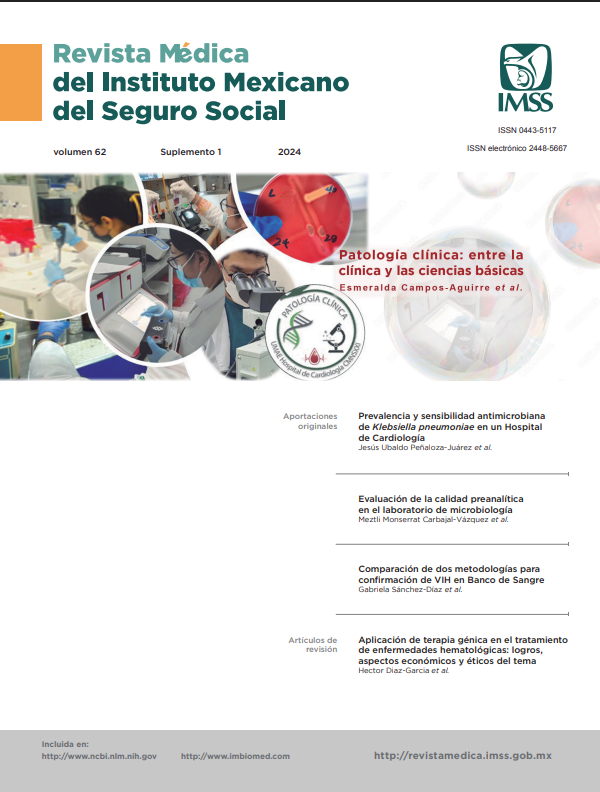Appropriate use of blood components in the adult population
Main Article Content
Keywords
Blood Transfusion, Transfusion of Blood Components, Transfusion Medicine
Abstract
Background: The use of blood components seeks to achieve a therapeutic effect to solve transfusion needs. In cases where they are indicated inappropriately, transfusion has not only a negative effect on the patient's life but also an increase in hospital stays.
Objective: To evaluate the appropriate use of blood components in the adult population of the services of the General Hospital of Zone No. 20.
Material and methods: Descriptive, cross-sectional, prospective study, non-probabilistic consecutive sampling, over 18 years of age, transfused during their hospital stay. Compared with national and international guidelines for the use of blood components, analyzed with descriptive and inferential statistics.
Results: 457 transfusions were included during May to October 2022, of which 62 transfusions (14%) presented inappropriate use. Erythrocyte concentrates are the most transfused, of which 50 transfusions were inappropriate case of platelets (120 concentrates and 5 platelet apheresis) they were used appropriately, while fresh frozen plasma demonstrated inappropriate use in 12 transfusions.
Conclusions: Due to the significant inappropriate use of blood components in the Hospital, it is necessary to implement improvement strategies in the management of blood components with the purpose of reducing risks and costs in administration.
References
Lin Y. Transfusion indications: An update in 2019. Pathology. 2019;51:S42. Disponible en: http://dx.doi.org/10.1016/j.pathol.2018.12.096.
Binder AF, Loos K, Peedin A, et al. Optimizing blood product utilization: A whole lot to gain and nothing to lose! J Clin Oncol. 2021;39(15_suppl):e18669–e18669. Disponible en: http://dx.doi.org/10.1200/jco.2021.39.15_suppl.e18669.
Wojtowicz MM, MacCallum S. An evidence based audit of fresh frozen plasma (FFP) use at seals pathology over winter 2016 and new local guidelines for appropriate use of FFP. Pathology. 2018;50:S64. Disponible en: http://dx.doi.org/10.1016/j.pathol.2017.12.150.
Dhesi AS, Moss R, Deelen R, et al. A survey of transfusion practitioners in international society of blood transfusion member countries. Vox Sang. 2020;115(3):200-10. Disponible en: http://dx.doi.org/10.1111/vox.12882.
Bruun MT, Georgsen J, Titlestad K, et al. Patient Blood Management - from local initiatives to European collaborations. ISBT Sci Ser. 2017;12(4):435-40. Disponible en: http://dx.doi.org/10.1111/voxs.12369.
Bielby L, Moss RL. Patient blood management and the importance of the Transfusion Practitioner role to embed this into practice. Transfus Med. 2018;28(2):98-106. Disponible en: http://dx.doi.org/10.1111/tme.12526.
Gammon RR, Coberly E, Dubey R, et al. Patient blood management—it is about transfusing blood appropriately. Ann Blood. 2022;7:21-21. Disponible en: http://dx.doi.org/10.21037/aob-21-70.
Shander A, Goobie SM, Warner MA, et al. Essential role of Patient Blood Management in a pandemic: A Call for Action: A call for action. Anesth Analg. 2020;131(1):74-85. Disponible en: http://dx.doi.org/10.1213/ANE.0000000000004844.
Secretaría de Salud, Asociación Mexicana de Medicina Transfusional A.C., Agrupación Mexicana para el estudio de la Hematología, A.C. Guía para el uso clínico de la sangre. 3a ed. México: Secretaría de Salud; 2007. 4. Ammtac.org. [citado el 30 de septiembre de 2023]. Disponible en: https://www.ammtac.org/docs/GuiasTransfusion/GuiaParaElUsoClinicoDeLaSangre.pdf.
Prevención y manejo de la hemorragia postparto. Guía de Práctica Clínica: Guía de Referencia Rápida: México, CENETEC; 2021 [citado el 30 de septiembre de 2023]. Disponible en: http://www.cenetec-difusion.com/CMGPC/GPC-SS-103-21/ER.pdf.
Manejo hemático del paciente. Guía de Práctica Clínica: Evidencias y Recomendaciones. México, CENETEC; 2020 [citado el 30 de septiembre de 2023]. Disponible en: http://www.cenetec-difusion.com/CMGPC/GPC-SS-830-20/ER.pdf.
Trejo-Gómora J, Salazar-Bailon J. Medicina transfusional en la pandemia de COVID-19. La visión del Centro Nacional de la Transfusión Sanguínea. Gac Med Mex. 2022;157(93). Disponible en: http://dx.doi.org/10.24875/gmm.m21000474.
Santa Cruz-Quiroz KR, Vásquez-Mejía JF, Soto-Cáceres VA, et al. Valoración de la calidad de prescripción de transfusión sanguínea en un hospital de alta complejidad en la región Lambayeque. Acta Médica Perú. 2019;36(2):88-95. Disponible en: http://dx.doi.org/10.35663/amp.2019.362.808.
Franchini M, Marano G, Veropalumbo E, et al. Patient Blood Management: a revolutionary approach to transfusion medicine. Blood Transfus. 2019;17(3):191-5. Disponible en: http://dx.doi.org/10.2450/2019.0109-19.
Shander A, Hardy J-F, Ozawa S, et al. A global definition of Patient Blood Management. Anesth Analg. 2022;135(3):476-88. Disponible en: http://dx.doi.org/10.1213/ane.0000000000005873.
Meybohm P, Richards T, Isbister J, et al. Patient blood management bundles to facilitate implementation. Transfus Med Rev. 2017;31(1):62-71. Disponible en: http://dx.doi.org/10.1016/j.tmrv.2016.05.012.
Kaserer A, Rössler J, Braun J, et al. Impact of a Patient Blood Management monitoring and feedback programme on allogeneic blood transfusions and related costs. Anaesthesia. 2019;74(12):1534-41. Disponible en: http://dx.doi.org/10.1111/anae.14816.
Brome-Uribe AP, Roldán-Tabares MD, Herrera-Almanza L, et al. Transfusiones al final de la vida. Revisión de algunas consideraciones importantes. Rev Soc Esp Dolor. 2021;28(1):47-52. Disponible en: https://dx.doi.org/10.20986/resed.2021.3831/2020.
Ramírez-Rodríguez JM, García-Erce JA, Arroyo-Sebastián A. «Regreso al futuro»: tras la pandemia debemos intensificar la recuperación. Cir Esp (Engl Ed). 2021;99(1):1-3. Disponible en: http://dx.doi.org/10.1016/j.ciresp.2020.07.016.
Castedo E, Martínez-Cabeza P, Miró M, et al. Aplicación de un programa de ahorro de sangre en cirugía cardiaca: análisis y resultados. Cir Cardiovasc. 2022;30(1):17-23. Disponible en: http://dx.doi.org/10.1016/j.circv.2022.07.003.
García-Erce JA, Laso-Morales MJ. «Patient blood management» en la Vía Clínica de Recuperación Intensificada en Cirugía Abdominal. Cir Esp. 2017;95(9):552-4. Disponible en: http://dx.doi.org/10.1016/j.ciresp.2017.02.001.
Shander A, Hardy J-F, Ozawa S, et al. A global definition of Patient Blood Management. Anesth Analg. 2022;135(3):476-88. Disponible en: http://dx.doi.org/10.1213/ANE.0000000000005873.
Courbil R, Manteau A-C. Reglas de compatibilidad y accidentes inmunológicos de la transfusión sanguínea. EMC - Anest-Reanim. 2020;46(2):1-10. Disponible en: http://dx.doi.org/10.1016/s1280-4703(20)43646-1.
Baron DM, Franchini M, Goobie SM, et al. Patient blood management during the COVID-19 pandemic: a narrative review. Anaesthesia. 2020;75(8):1105-13. Disponible en: http://dx.doi.org/10.1111/anae.15095.
Bolcato M, Russo M, Trentino K, et al. Patient blood management: The best approach to transfusion medicine risk management. Transfus Apher Sci. 2020;59(4):102779. Disponible en: http://dx.doi.org/10.1016/j.transci.2020.102779.


